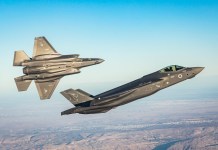5th gen fighter jets were considered a marvel when they came into existence. The US operated fighter jets like F-22s and F-35s became household names as they revolutionized aerial combats. However, experts say that the end 5th generation aircraft is near with the arrival of 6th gen jets.
Rafale vs Chengdu J-20: How Will Indian Rafale Jets Compete Against Chinese ‘Stealth’ J-20s?
Writing for the National Interest, Mizokami believes that the 6th generation fighter jet will feature decisive improvements over current-gen fighters, making air forces deadlier and more effective than ever before.
These improvements could possibly include addition/usage of artificial intelligence, drones, laser weapons and increased flying range.
Drone and Increased Range
Drone technology will play a bigger role when 6th gen jets get commissioned. Drones could be used alongside 6th gen fighter jets to carry an assortment of missions including, but not limited to, searching and destroying enemy surface-to-air radars, waiting for careful radar operators to turn their radars back on, broadcasting powerful jamming signals, or impersonate the sixth-generation fighter on the radar.
China Criticizes US’ Love for India; Double Standards Over Kashmir & Xinjiang
In Mizokami’s opinion, if a mission is intercepted by enemy fighters, drones armed with air-to-air missiles could outflank the enemy or act as bait, drawing them into a trap laid by the manned fighters. Additionally, other drones could act as flying magazines for the manned fighters, carrying even more precision-guided missiles to drop on enemy targets.
The addition of drones will allow air forces to buy back numbers of aeroplanes overall while the cost of manned aircraft skyrockets. They will also allow fighter pilots to not enter dangerous or heavily guarded airspace, thus saving human lives.
Russian Technicians Keeping INS Vikramaditya Battle Ready Amid Flaring Regional Tensions
Every generation of fighter jets has increased flying range and 6th gen fighters would try and do the same. Currently, 5th gen fighters in countries in North America, Europe, and Asia are multirole aircraft with a fairly typical combat radius of only 670 nautical miles.
As tensions increase in the Pacific due to Chinese aggression or as countries prepare for a potential battle over the frozen arctic, increased range for fighter jets is on the mind of many. The vastness of the Pacific Ocean, as well as Eastern Europe and European Russia, means that tactical aircraft may have to travel long ranges to reach their targets.
India or China: Whom Did Israel Support During The Intense India-China Border Standoff?
This situation is further complicated by the abundance of tactical and short-range ballistic missiles in Russian and Chinese inventories, and efforts by both countries to cripple U.S. and NATO airpower by targeting tankers and early warning aircraft with long-range missiles.
Laser Weapons and Artificial Intelligence
The introduction of laser weapons could revolutionize short-range aerial warfare, according to Mizokami. At present, the popular F-35 use chemical energy guns in the 20 – 30 mm range and has retained guns but the need to store all the weapons, fuel, and sensors inside the aircraft fuselage which severely restrict the size of the gun magazine.
US-China Tensions: US Wants India To ‘Match Its Weight By Actions’ In The South China Sea – Experts
However, with the addition of laser weapons, the weapon would simply require the laser and draw power from the aircraft’s engine or engines, storing it and then releasing it in pulses of the concentrated beam. This would be a massive improvement in chemical energy guns.
Why Is India Buying More Russian Jets Instead Of ‘Highly-Competent’ Rafale Aircraft?
Agreed that laser might need an energy storage system, but it would theoretically have an unlimited number of shots. Additionally, a laser would travel in an absolutely straight line at 186,000 miles a second, making hitting enemy aircraft much easier and it could also be used as a defensive weapon system, shooting down incoming air-to-air missiles.
Flying a 5th gen fighter jet is a herculean task in itself and the abundance of sensor data from the pilot’s aircraft, nearby aircraft, ships, ground forces, satellites, and other sources of information makes it not any easier. Therefore, having artificial intelligence( AI) systems that could prioritize information shared with the pilot would a great technological advancement.
CPEC Project A ‘Trillion-Dollar Blunder’, Pakistan Calls It ‘Outstanding Initiative’
The possibilities for AI being incorporated with 6th gen fighter jets are endless. It could be used to keep a check on drones flying alongside the 6th gen fighter, monitor fuel use, range, and weapons. It could recommend alternate landing sites for damaged aircraft, taking into consideration range, airfield condition and damage to the manned fighter, and make the necessary fuel and range calculations.
Not only this, but AI could also assign other less pressing data to other AIs to keep abreast of developments and bring it to the master AI—or pilot’s—attention as it grows in relevance to the mission.
The arrival of 6th gen fighter jets by no means indicate the complete demise of 5th generation jets. The 6th gen jet would naturally incorporate the feature set of a fifth-generation jet, but what technology it incorporates would set it apart.





